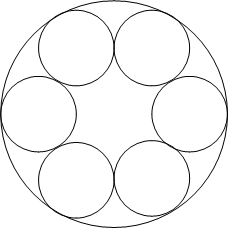Difference between revisions of "2005 AIME I Problems/Problem 1"
I_like_pie (talk | contribs) (Image Added) |
m (fix error (noted by JBL)) |
||
| Line 1: | Line 1: | ||
== Problem == | == Problem == | ||
| − | Six [[circle]]s form a ring with with each circle [[externally tangent]] to two circles adjacent to it. All circles are [[internally tangent]] to a circle <math> C </math> with [[radius]] 30. Let <math> K </math> be the area of the region inside circle <math> C </math> and outside of the six circles in the ring. Find <math> \lfloor K \rfloor</math> (the [[floor function]]). | + | Six [[congruent]] [[circle]]s form a ring with with each circle [[externally tangent]] to two circles adjacent to it. All circles are [[internally tangent]] to a circle <math> C </math> with [[radius]] 30. Let <math> K </math> be the area of the region inside circle <math> C </math> and outside of the six circles in the ring. Find <math> \lfloor K \rfloor</math> (the [[floor function]]). |
[[Image:2005 AIME I Problem 1.png]] | [[Image:2005 AIME I Problem 1.png]] | ||
| Line 9: | Line 9: | ||
== See also == | == See also == | ||
{{AIME box|year=2005|n=I|before=First Question|num-a=2}} | {{AIME box|year=2005|n=I|before=First Question|num-a=2}} | ||
| + | |||
| + | [[Category:Intermediate Geometry Problems]] | ||
Revision as of 14:13, 2 December 2007
Problem
Six congruent circles form a ring with with each circle externally tangent to two circles adjacent to it. All circles are internally tangent to a circle ![]() with radius 30. Let
with radius 30. Let ![]() be the area of the region inside circle
be the area of the region inside circle ![]() and outside of the six circles in the ring. Find
and outside of the six circles in the ring. Find ![]() (the floor function).
(the floor function).
Solution
Define the radii of the six congruent circles as ![]() . If we draw all of the radii to the points of external tangency, we get a regular hexagon. If we connect the vertices of the hexagon to the center of the circle
. If we draw all of the radii to the points of external tangency, we get a regular hexagon. If we connect the vertices of the hexagon to the center of the circle ![]() , we form several equilateral triangles. The length of each side of the triangle is
, we form several equilateral triangles. The length of each side of the triangle is ![]() . Notice that the radius of circle
. Notice that the radius of circle ![]() is equal to the length of the side of the triangle plus
is equal to the length of the side of the triangle plus ![]() . Thus, the radius of
. Thus, the radius of ![]() has a length of
has a length of ![]() , and so
, and so ![]() .
. ![]() , so
, so ![]() .
.
See also
| 2005 AIME I (Problems • Answer Key • Resources) | ||
| Preceded by First Question |
Followed by Problem 2 | |
| 1 • 2 • 3 • 4 • 5 • 6 • 7 • 8 • 9 • 10 • 11 • 12 • 13 • 14 • 15 | ||
| All AIME Problems and Solutions | ||










